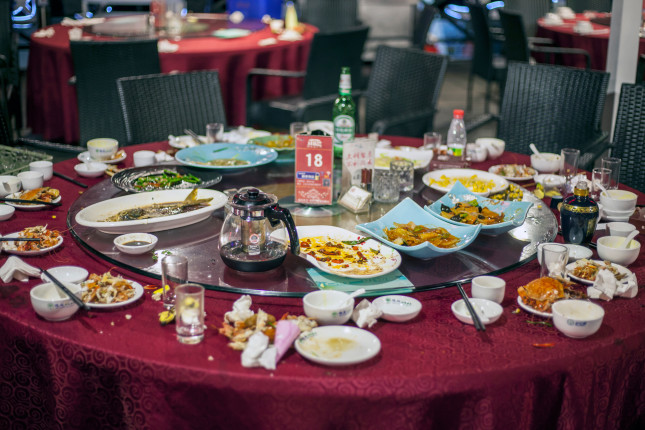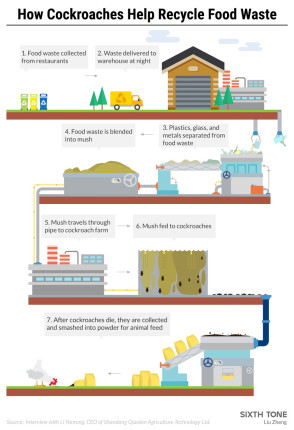-
From Farm to Table to Landfills? Seeking Solutions to China’s Food Waste Dilemma

In a giant building filled with dark and humid rooms, some 2 billion cockroaches are scampering around piles of food. This is not a scene out of a horror film, but an innovative business venture to help Jinan, a “small” city of 9 million in northeast China, deal with its overfull food waste. Jinan produces more than 6,000 tons of solid waste each day, and like most Chinese cities, 50 to 70 percent of it is food waste. To divert more organic waste from landfills, the municipal government partnered with the Zhangqiu District Food Waste Processing Center to use cockroaches to dispose of the 60 tons of food waste daily from district restaurants and companies as well as households in 40 waste-sorting pilot villages. The company is highly profitable as it gets the food waste for free from the city; and city then gives subsidies for each ton of food waste processed. The company also sells some 2,433 tons of dead cockroaches each year as animal feed additives. However, the small six-legged workers only devour some 100 tons of food waste per day even with expansion plans for two new factories, a mere 1.6 percent of the city’s total waste. Cockroaches alone cannot conquer the city’s food waste challenge.
Scaling China’s Food Waste Mountains
Jinan is a microcosm of China’s food waste problems. Chinese cities produce 25 percent of the world’s municipal solid waste, most of it food. According to China’s City Food Waste Report by World Wildlife Fund (WWF) and the Chinese Academy of Sciences, restaurants, and schools in China’s cities waste around one-third of the food they serve. The Chinese Academy of Agricultural Sciences reported the annual food loss before reaching consumers totaled 31.75 million metric tons, or 6 percent of China’s total food production.
So where do these mounds of food waste end up? Most of China’s food waste is either landfilled, burned, or fed to animals—all strategies that do nothing to minimize waste generation. With support from the Global Methane Initiative, the China Environment Forum took a deep dive into China’s food waste disposal trends in its From Farm to Chopsticks to Energy: Co-digesting China’s Urban Food Waste in Wastewater Treatment Plants report.
From Farm to Table to Energ… by on Scribd
Municipal landfills in China accepted more than 152 metric megatons of urban waste in 2017, most of which was organic waste. Today with more than 2000 landfills nearly full, Chinese cities are shifting to waste incineration. All four of Jinan’s landfills are overflowing, prompting the city to open a new incinerator in April 2018, which can process 3,400 tons of waste daily, more than half of the city’s total waste. Eight months later, another waste-to-energy incinerator started burning 1,200 tons of solid waste every day to generate some 163 million kilowatt-hours per year, enough electricity for 250,000 Jinan households each year.
Incineration plants in China have nearly tripled in number since 2010, but they have a significant Achilles heel: waste moisture content. Incinerators cannot easily burn wet food waste. Chinese incinerators struggle to burn urban solid waste because its 50-70 per cent moisture content. Incineration plants also are facing NIMBY (Not-in-my-backyard) opposition. For example, when the Shenzhen government announced plans to build the world’s largest incinerator in 2015, 5,000 residents protested the plant’s lack of transparency around its potential environmental impact. After three years in court, the community successfully sued the government in 2018 to release an environmental impact assessment. The municipal government has moved ahead with construction, agreeing to apply the highest emission standards and creating an online monitoring system.
An alternative disposal route is feeding food residue to animals, a centuries-old practice. Restaurants in Jinan used to illegally sell their food waste as animal feed, leaving them reluctant to give out food waste to the government for free. In 2010, it was estimated that 80 percent of China’s collected food waste was used as pig feed. However, the metals, plastics, and potentially pathogenic microorganisms contained in urban food waste is not healthy for animal consumption. The potential risks to food security and human health have led Chinese municipalities to ban the use of food waste for animal feed, although enforcement of these rules remains uneven.
Anaerobic digestion (AD)—a process that transforms organic waste into biogas—is one of the most underutilized forms of efficient food waste disposal used in China. The biogas, produced by bacteria as they digest the organic waste, can be used as energy on-site, or converted into biofuel. Across China, cities are experimenting with making biogas from food waste (sometimes together with wastewater sludge) to generate electricity and other marketable products, such as digestate. Many wastewater/food waste AD plants in the United States offer models for China.
Beyond Cockroaches
China’s post-consumer food waste crisis is not only crippling cities, but also wasting the country’s limited water, energy, and land. Moreover, this waste generates considerable methane, a major greenhouse gas. Also, every kilogram of landfilled municipal solid waste can release its equivalent weight of CO2.
To modernize municipal waste treatment, in 2017 the Ministry of Housing and Rural Development (MOHURD) mandated the creation of 46 waste-sorting pilot cities. Jinan drafted its own comprehensive domestic garbage sorting plan (2018–2022) requirement. Jinan and the central government efforts have focused primarily on the final food waste disposal stage, with little attention paid to the earlier stages of waste creation, i.e., changing consumer behavior. Some local governments and nongovernmental organizations have created short-lived campaigns targeting consumer food waste, such as the failed empty plate campaign.
In the United States, where 40 percent of all food is wasted, many cities are seeking strategies to reduce waste or divert it away from landfills. In Illinois, the legislature passed a law in 2018 mandating state agency consider compost in landscaping projects when cost competitive. This type of legislation can help create a market for food waste compost. In 2015, the Natural Resources Defense Council launched the Nashville Food Waste Initiative (NFWI), which piloted food waste prevention and process projects. NFWI’s Project Director Linda Breggin says, “cities are the front lines of addressing the problem, and this project helps us understand which local approaches are most effective for measuring and preventing food waste, rescuing surplus food, and recycling food scraps.”
China must start exploring waste prevention projects like Nashville. Over the past two years, Chinese leadership has expanded its war on pollution to include the country’s solid waste crisis, and new policies and pilots are rapidly emerging. In 2016, China amended its Solid Waste Law to improve oversight and transparency of waste generators and halt illegal dumping and promote recycling and reuse of wastes, including food. Liu Xiao, a senior technical expert for China Low-carbon Integrated Waste Management for Deutsche Gesellschaft für Internationale Zusammenarbeit (GIZ), was encouraged by “China’s Ministry of Ecological Environment jump-starting an ambitious Zero-Waste City plan in late 2018 that targets extended producer responsibility and reduction of all forms of urban waste.” These Zero-Waste City pilots represent China’s first major shift away from the current landfill or incineration-first practices that threaten air, water, soil and human health.
Linda Breggin, also stresses that “diverting food waste from landfills can reduce a city’s carbon footprint, help feed those in the city who struggle with hunger and, in some cases, reduce waste management costs.” In other words, minimizing food waste rather than locking in disposal infrastructure is a smarter strategy to help China win more battles in its war against waste pollution.
Jiaqiao Xiang is a research assistant at the Wilson Center’s China Environment Forum in Washington, D.C. He is a Junior Global Leadership Scholar on an exchange at NYU DC and pursuing his Bachelor’s degree at NYU Shanghai.
Jennifer L. Turner is the Director of the China Environment Forum at the Woodrow Wilson Center in Washington, D.C. She is also the manager of the Wilson Center and Circle of Blue’s Global Choke Point Initiative.
Sources: BioCycle, CGTN, China Environment Forum, China Women’s News, Chinese Academy of Agricultural Sciences, Fenghuang News, Forward Information Business Co., Food and Agriculture Organization of the United Nations(FAO), People.cn, Qilu Evening News, Savethefood.com, Sixth Tone, Sohu.com, State Council of the People’s Republic of China, The Official Information Portal on Anaerobic Digestion, The Paper, United States Environmental Protection Agency, World Wildlife Fund (WWF), Waste-cwin.org, Xinhua Net,163 news.
Photo Credits:
evgenii mitroshin via Shutterstock (
Photo ID:270304728) . All rights reserved. How Cockroaches Help Recycle Food Waste via Sixth Tone, Sep 07, 2018.
 A Publication of the Stimson Center.
A Publication of the Stimson Center.







